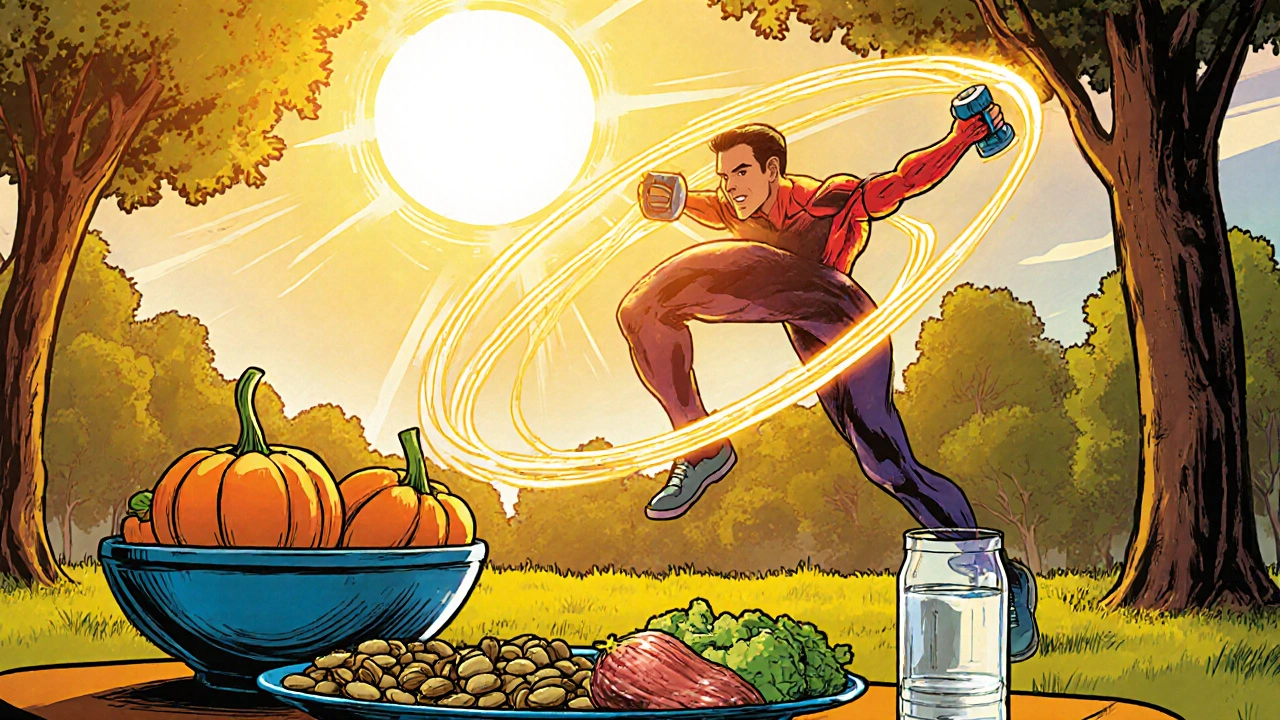Calcium Intake Calculator
Find out how much calcium you're getting from your diet and get tailored recommendations based on the article's natural approach to calcium deficiency.
Your Daily Calcium Intake
Your Results
Your daily calcium intake: 0 mg
Calcium deficiency is a condition where the body doesn’t have enough calcium to keep bones, teeth, and muscles working properly. Low blood calcium can cause tingling sensations, muscle cramps, and even mood changes. While doctors can prescribe supplements, many people prefer natural ways to boost their calcium levels and support overall bone health.
What Triggers Low Calcium?
Several factors can pull calcium out of balance:
- Poor diet that lacks calcium‑rich foods.
- Insufficient vitamin D, which helps the gut absorb calcium.
- High caffeine or soda intake, which can increase calcium loss through urine.
- Certain medications, like long‑term steroids.
- Health conditions such as malabsorption syndromes.
Identifying the root cause helps you pick the right natural remedy.
Why Choose Natural Remedies?
Natural approaches work with the body’s own systems. Foods provide a package of nutrients that act together, while lifestyle tweaks improve absorption and reduce loss. Plus, whole‑food sources avoid the stomach upset that some synthetic calcium pills can cause.

Calcium‑Rich Foods to Add Immediately
Choosing the right foods is the cornerstone of a natural plan. Below is a quick look at how much calcium you get from everyday items.
| Food | Calcium (mg) |
|---|---|
| Low‑fat milk | 125 |
| Greek yogurt | 110 |
| Cheddar cheese | 720 |
| Almonds (raw) | 264 |
| Tofu (calcium‑set) | 350 |
| Broccoli (steamed) | 47 |
| Kale (raw) | 150 |
| Fortified soy milk | 300 |
| Sardines (with bones) | 382 |
Notice that plant‑based options like fortified soy milk and tofu can rival dairy. If you’re lactose intolerant or vegan, these are excellent alternatives.
Boost Vitamin D for Better Absorption
Vitamin D a fat‑soluble vitamin that enhances calcium uptake in the gut works hand‑in‑hand with calcium. Sunlight is the cheapest source-about 10‑15 minutes of midday sun on face, arms, and legs two to three times a week can produce enough vitamin D for most adults. If you live in a cloudy climate (like the UK) or spend most time indoors, add these foods:
- Fatty fish (salmon, mackerel)
- Egg yolks
- Fortified cereals and plant milks
When diet and sun aren’t enough, a modest daily supplement (800‑1,000 IU) can fill the gap.
Supporting Minerals: Magnesium and Vitamin K2
Calcium doesn’t work in isolation. Two other nutrients keep the balance right:
- Magnesium helps activate vitamin D and moves calcium into bone tissue. Good sources are pumpkin seeds, black beans, and whole grains.
- Vitamin K2 guides calcium to the skeleton and away from arteries. Fermented foods like natto, hard cheeses, and sauerkraut are rich in K2.
Including a handful of these foods each day improves calcium utilization and reduces the risk of arterial calcification.

Lifestyle Tweaks That Keep Calcium Where It Belongs
Beyond diet, a few daily habits make a big difference:
- Weight‑bearing exercise: Walking, dancing, or resistance training stimulates bone‑forming cells. Aim for 30 minutes, three times a week.
- Limit caffeine to <300mg per day (about two cups of coffee). High caffeine increases urinary calcium loss.
- Swap sugary sodas for water or herbal tea. Phosphoric acid in colas can leach calcium from bones.
- Stay hydrated but avoid excessive urine‑bladder irritants like excess alcohol.
These steps are simple, inexpensive, and reinforce the dietary gains you’re making.
Key Takeaways
- Identify the cause of low calcium-diet, vitamin D, caffeine, or medication.
- Load up on calcium‑rich foods: dairy, fortified plant milks, leafy greens, nuts, tofu, and fish with bones.
- Ensure adequate vitamin D through safe sun exposure or fortified foods.
- Support calcium with magnesium and vitamin K2 for better bone deposition.
- Combine diet with weight‑bearing exercise and limit calcium‑wasting drinks.
Frequently Asked Questions
Can I fix calcium deficiency without supplements?
Yes. A diet rich in calcium, vitamin D, magnesium, and vitamin K2, combined with sunlight and weight‑bearing activity, can often raise blood calcium to normal levels. Supplements may still be useful for severe cases or when sun exposure is limited.
How much calcium do adults need each day?
The UK reference intake for adults is 700mg per day. Women over 50 and men over 70 should aim for 1,200mg, mainly from food sources.
Is sunlight really enough for vitamin D?
In sunny climates, 10‑15 minutes of midday sun a few times a week is usually sufficient. In the UK, especially during winter, you’ll often need fortified foods or a modest supplement (800‑1,000IU daily).
What are the best plant‑based calcium sources?
Fortified soy or oat milk, calcium‑set tofu, almonds, and leafy greens like kale and bokchoy provide the highest amounts. Pair them with vitaminD‑rich foods to improve absorption.
Can high caffeine intake worsen calcium loss?
Yes. Each cup of coffee can increase calcium excretion by about 6mg. Keeping caffeine under 300mg per day helps maintain a healthier calcium balance.

Edward Morrow
September 20, 2025
America's got the strongest bones thanks to real food, not some weak‑lime‑water supplements.
Shayne Tremblay
September 22, 2025
Hey folks, you can totally power up your calcium game with everyday foods-milk, kale, almonds, you name it!
Just add a splash of fortified soy milk to your morning coffee and you’re already ahead.
Keep it fun and mix in some tasty snacks, your bones will thank you.
Stephen Richter
September 24, 2025
While the enthusiasm is appreciated the factual accuracy of the nutrient values must be verified against established dietary databases. Additionally the recommendation to consume dairy without regard for lactose intolerance may alienate certain readers.
Musa Bwanali
September 26, 2025
Listen up, you don’t need a pharmacy aisle full of pills when a solid plate of cheese, sardines, and a quick jog can do the trick. Grab those calcium power foods and hit the weights-your skeleton will thank you.
Allison Sprague
September 28, 2025
First off, let me point out the glaring oversimplifications in the advice above-suggesting a one‑size‑fits‑all approach to calcium intake is both reckless and intellectually lazy.
People have vastly different absorption capacities, influenced by genetics, gut health, and existing medical conditions; assuming everyone can just chug cheese without repercussions ignores the reality of hypercalcemia risk.
Moreover, the article cavalierly mentions “limit caffeine” but fails to quantify what constitutes a dangerous amount, leaving readers in the dark.
It also neglects the interplay of phosphate, a mineral that can sabotage calcium utilization if consumed in excess from soda and processed foods.
Dietary calcium isn’t the only player; vitamin D status, magnesium levels, and even hormonal fluctuations in women affect bone turnover dramatically.
For instance, post‑menopausal women often require higher calcium plus vitamin K2 to redirect calcium away from arterial walls-a nuance absent from the piece.
Another glaring omission is the impact of high‑protein diets on calcium balance; while protein is essential, excess animal protein can increase urinary calcium loss, a fact the article glosses over.
The suggestion to “add fortified soy milk” is commendable, yet the writer forgets to mention the potential for added sugars and additives that may undermine overall health goals.
Furthermore, the reliance on anecdotal “10‑15 minutes of midday sun” ignores latitude, skin tone, and sunscreen usage, all of which drastically alter vitamin D synthesis.
Even the recommended “weight‑bearing exercise” lacks specificity-there’s a huge difference between leisurely walking and high‑impact plyometrics on osteoblast activation.
And let’s not overlook socioeconomic barriers; recommending sardines or specialty fermented foods like natto assumes access that many readers simply don’t have.
Finally, the tone oscillates between overly aggressive nationalism and vague health advice, which can alienate international audiences seeking evidence‑based guidance.
In summary, a responsible article would present a nuanced, evidence‑backed framework, cite reputable sources, and acknowledge individual variability rather than peddling generic hype.
leo calzoni
September 30, 2025
Honestly, if you want real results stop chasing fad diets and just eat the basics: dairy, nuts, and a bit of fish.
KaCee Weber
October 2, 2025
🌟Hey wonderful community!🌟 I love how this post celebrates both plant‑based and animal sources of calcium-there's room for everyone at the table! 🌱🥛
Remember to sprinkle in some magnesium‑rich pumpkin seeds and a dash of vitamin K2 from fermented goodies, and your bones will feel like they’re dancing! 💃🦴
Also, a quick tip: a splash of orange juice fortified with calcium and vitamin D can be a tasty morning boost. Keep sharing your favorite combos, and let’s keep each other motivated! 😊
jess belcher
October 4, 2025
Good points, thanks for adding cultural variety to the calcium debate.
Sriram K
October 5, 2025
From a practical standpoint, try tracking your intake with a simple spreadsheet-list each food, its calcium content, and total daily grams. This visual can quickly highlight gaps and guide you toward balanced meals.
Deborah Summerfelt
October 7, 2025
Sure, but if you’re already bathing in sunlight, why bother with all this calcium talk?
Maud Pauwels
October 8, 2025
Interesting info thanks for sharing
Scott Richardson
October 9, 2025
America should lead the world in bone health, not lag behind with weak diets.
Laurie Princiotto
October 10, 2025
🙄 Another “miracle” diet? Give me a break. 😒